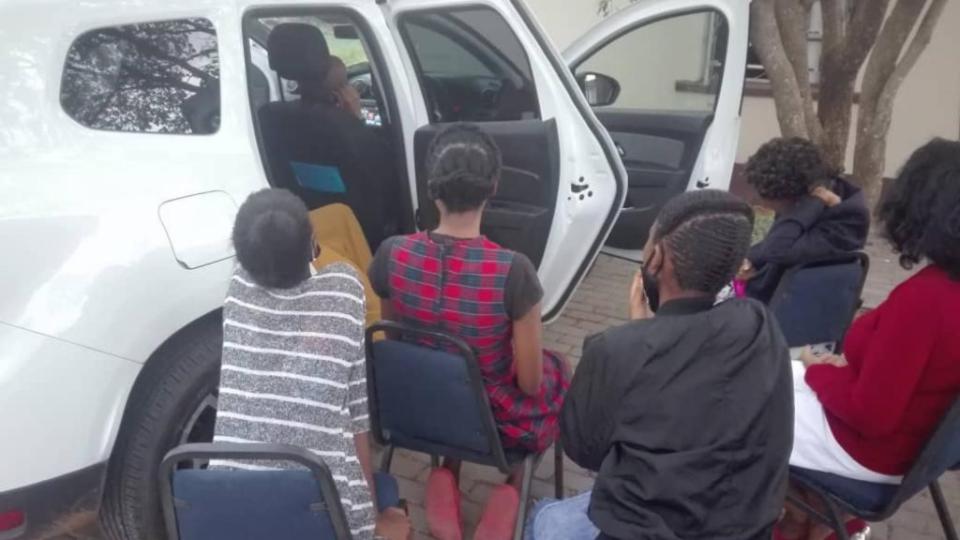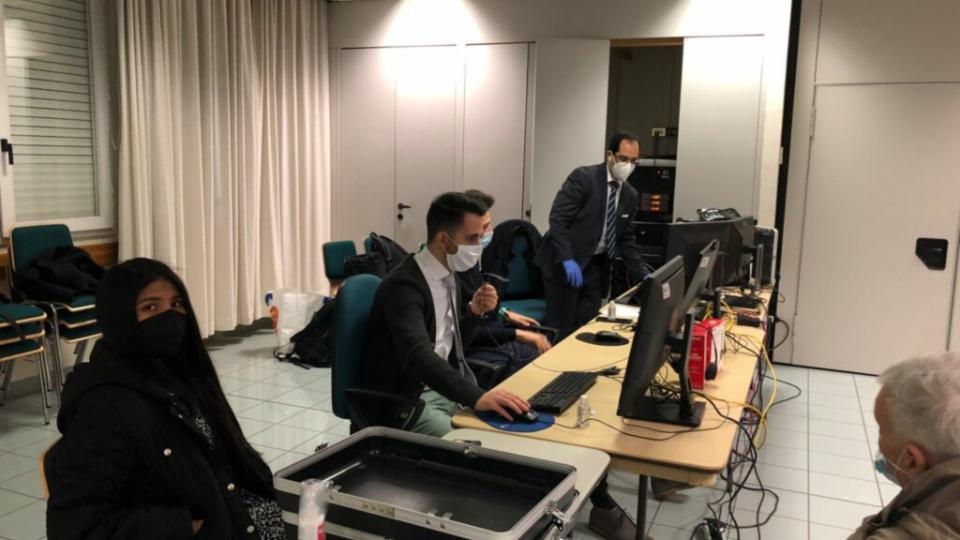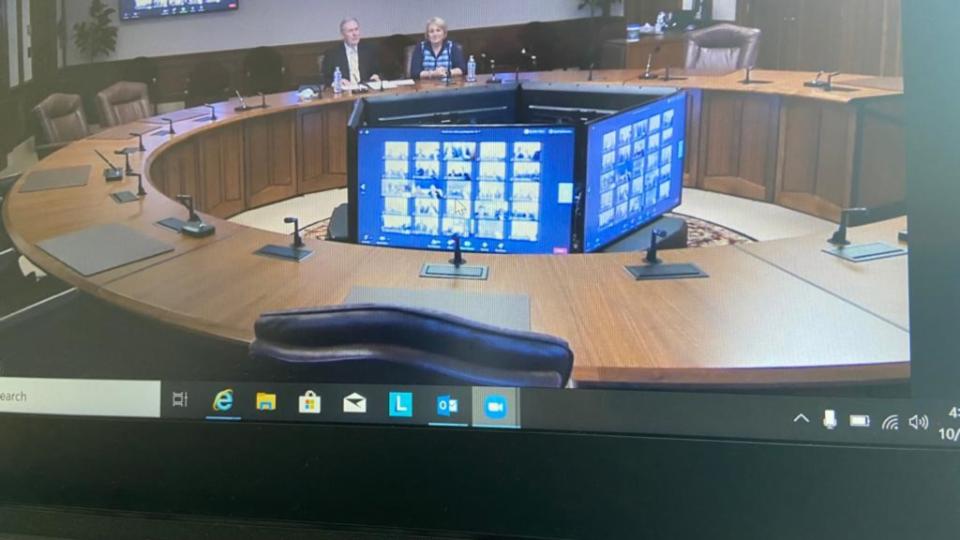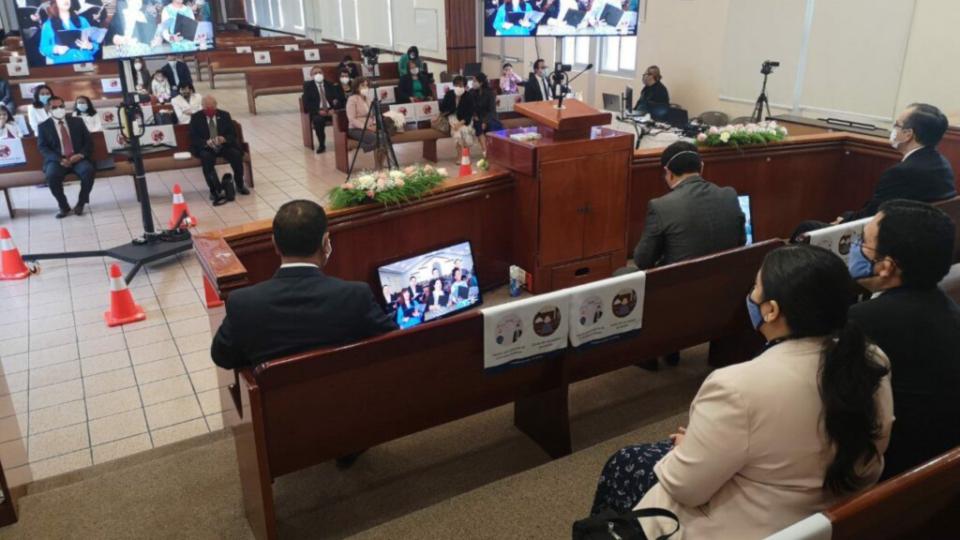| Temple Square is always beautiful in the springtime. Gardeners work to prepare the ground for General Conference. © 2012 Intellectual Reserve, Inc. All rights reserved. | 1 / 2 |
This story appears here courtesy of TheChurchNews.com. It is not for use by other media.
By Scott Taylor, Church News
Elder John C. Pingree Jr. won’t soon forget when The Church of Jesus Christ of Latter-day Saints first suspended stake conferences in March 2020 because of the COVID-19 pandemic.
The General Authority Seventy and first counselor of the Mexico Area Presidency was in Hermosillo, Mexico, concluding a temple review there and set to preside over a weekend stake conference. One of the local stake presidents — called a few months earlier to serve as a mission president later that summer — was to be released as part of a stake presidency reorganization at the conference.
While in Hermosillo, Elder Pingree received the March 12, 2020, letter from the First Presidency and Quorum of the Twelve Apostles to Church leaders and members, suspending all public Church meetings and activities — including stake conferences — due to the pandemic.
“Everything just stopped like that,” recalled Elder Pingree, who promptly returned to area headquarters in Mexico City without conducting the stake conference or reorganization. “From there through April and May, we were trying to help members focus on having sacrament meetings in their homes.”
While local worship meetings transitioned to the home and general conference sessions went online, stake conferences initially were left in limbo — despite a number of stake presidencies needing to be reorganized because of a president’s move or death.
The evolution of stake conferences worldwide during a pandemic year has gone from the complete suspension to a gradual resuming of conferences. Today, more than a year later, many are conducted in hybrid fashion, combining videoconferencing and other delivery methods via technology with limited in-person attendance, although some are having to return to all-virtual conferences because of ongoing COVID-19 conditions.
Given that the Church has 22 areas and nearly 3,500 stakes worldwide, thousands of stories from the past year about stake conferences and stake presidency organizations could be told. The Church News interviewed President M. Russell Ballard, Acting President of the Quorum of the Twelve Apostles, and nearly a dozen General Authority Seventies who serve in area presidencies across the globe about their experiences and insights regarding pandemic-period stake conferences.
‘The Lord Provided a System’
“We are in a different world,” President Ballard said. “But even though the pandemic hit the world, the Lord provided us a system whereby we could still stay in touch with our people.”
That “system” includes the widespread use of Zoom, Microsoft Teams and other similar software applications that deliver videoconferencing capabilities to the masses through desktop and laptop computers, tablets, and smartphones.
“It is not like being in the same room where you can see their faces and shake their hands,” said President Ballard of virtual stake and priesthood leadership conferences. “But it is wonderful that you can do it, when you can get to them any way you can.”
“We had the philosophy that we did not want COVID-19 to dampen our enthusiasm for the restored gospel of Jesus Christ, so we stay connected with our leadership and members as much as we can through technology,” said Elder S. Gifford Nielsen, who presides over the North America Central Area. “We found that extending ourselves and really showing how much we care about each other went a long way in helping those we serve in a significant, spiritual way.
“And,” he added, “Zoom calls, telephone calls and streaming became our friends.”
Direction and Assignment
Stake conferences are under the direction of the President of the Quorum of the Twelve Apostles, who calls for the conference and assigns the dates and the presiding leader, as well as an accompanying authority for the pair of leaders needed when stake presidencies are reorganized.

Stakes-4.jpeg
Young single adults in Gaborone, Botswana, use cellphones, car speakers and Wi-Fi from a nearby at-capacity meetinghouse to listen to a broadcast session of a multistake conference with leaders and members in Botswana and South Africa in November 2020. Photo courtesy of the Africa South Area Presidency.© 2021 Intellectual Reserve, Inc. All Rights Reserved.During the pandemic period, when area leaders had questions or concerns regarding the hows, whens and whys to conduct certain stake conferences, they worked closely with the Office of the President of the Quorum of the Twelve Apostles, which in turn consults with the First Presidency and the Twelve.
Area leaders also work closely with the Apostles and members of the Presidency of the Seventy who oversee their respective areas.
In addition to the March 12, 2020, letter suspending stake conferences and all public meetings, subsequent correspondence from Church leaders first allowed the careful resumption of regular Church meetings — by broadcasting via technology — beginning in late May.
The Church-wide start of stake conferences with presidency reorganizations followed in late summer, with the resumption of regular stake conferences — albeit done mostly virtually — beginning November 1.
Postponed by Pandemic
Early on, stake conferences were simply postponed. Elder Adilson de Paula Parrella, president of the Brazil Area, tells of a stake in Santarém, Brazil, located in a remote area along the Amazon River midway between Manaus and the country’s northeastern coast. “The stake president, who had been serving for nearly 10 years, volunteered to stay another year, if needed, until a stake reorganization conference could be held in person. These are men of faith and complete devotion.”
But as the pandemic continued to drag on, the need increased for stake conferences — particularly presidency reorganizations. Some leadership adjustments were needed due to a stake president’s illness, death, relocation or other needs to be released. In some cases, a first counselor was authorized to lead during the interim, until the presidency could be reorganized.
Elder Jorge F. Zeballos, president of the South America Northwest Area, pointed to two stake presidency reorganizations needing to be conducted in Peru in late May 2020 — one in Chiclayo, and the other in Iquitos. Both were held May 30 to 31, following the COVID-19-related deaths of the two stake presidents.
A return to stake conferences and presidency reorganizations has been done primarily through technology, usually web broadcasts and videoconferencing to members — first in their homes, with broadcasts to meetinghouses increasingly being used as local protocols allow.
At first, only the Sunday general sessions were held, unless a reorganization was being held, in which case the regular series of interviews and calls was conducted as well. Later, leadership instruction meetings began to be included in virtual stake conferences, followed by an increasing number of in-person opportunities.
Elder S. Mark Palmer, Africa South Area president, recalled his area’s first resumed conference. It was a multistake conference with Elder Neil L. Andersen of the Quorum of the Twelve Apostles and Elder Terence M. Vinson of the Presidency of the Seventy, who were joined by their wives via videoconference from Salt Lake City.

Stakes-5.jpeg
Members check the audiovisual equipment prior to streaming the stake conference for the Milan Italy Stake in early 2021. Photo courtesy of the Europe Area Presidency.© 2021 Intellectual Reserve, Inc. All Rights Reserved.Meanwhile, Elder Palmer and Elder Edward Dube of the area presidency and their wives joined in from Johannesburg, South Africa, along with members and leaders gathered in Pretoria and Mabopane, South Africa, and Gaborone, Botswana.
Members participated from their homes and from meetinghouses, including one location where the congregation literally sat in the dark when the power went out during a storm — but they still watched via cell service. In another location, a handful of members stood around a car in a parking lot, focused on a cellphone powered by the running car.
“These members were so thrilled to be gathered together in small groups after so many months of no meetings,” Elder Palmer said. “Being taught by an Apostle of the Lord was surely a highlight of this challenging year.”
Two-Way Communications
Whether it be general conferences or devotionals, broadcasts have proven effective for Church leaders addressing Latter-day Saints in mostly one-way transmissions. For most stake conferences, a streamed broadcast works well for the Sunday general session, with speakers addressing the congregation.
Leadership instruction sessions of stake conference meetings benefit from two-way interactions, while conducting interviews and extending releases and calls in the reorganization of a stake presidency requires videoconferencing capabilities.
While a single leader can be assigned to preside at a regular stake conference, stake presidency reorganizations are done with two assigned leaders — typically a General Authority accompanied by an Area Seventy.
Travel restrictions during the pandemic — both international and, at times, within a single nation — often hindered assigned leaders attending a stake conference in person. Sometimes only one leader has been able to attend in person — as in cases where an Area Seventy is living in close proximity and able to reach the conference according to regulations — and the other leader has joined via videoconference. Other times, both leaders have been remote, participating only through technology.
Interviews, Calls and Settings Apart
“Interviews are conducted in a fashion that allows the people to see and hear each,” said Elder Ian S. Ardern, president of the Pacific Area, who presided over his first virtual stake conference in Australia from the area headquarters city of Auckland, New Zealand.
“The impressions of the Spirit that I have experienced in calling a new stake president via electronic means have been no different than extending the call in person,” he said. “Distance, time differences and being personally present are not inhibitors to the promptings of the Holy Ghost.”

Stakes-6.jpeg
Elder Terence M. Vinson of the Presidency of the Seventy and his wife, Sister Kay Vinson, participate in a November 2020 multistake conference from Salt Lake City, surrounded by video monitors showing leaders and members from South Africa and Botswana. Photo courtesy of the Africa South Area Presidency.© 2021 Intellectual Reserve, Inc. All Rights Reserved.But distances did create a problem, when the assigned authorities were not in attendance in person to set apart the new presidency. In those extreme cases, and with appropriate approval, a designated local priesthood holder was authorized to set apart the new stake president, Elder Zeballos explained.
“Each time we could not get to the stake conference location, we proposed to President M. Russell Ballard a worthy high priest of that stake to be delegated authorization to set apart the new stake president. This has been a great blessing to patriarchs, former stake presidents and other brothers who have been delegated this unusual privilege.”
Said President Ballard: “We make decisions predicated on what we prayerfully think makes sense. … We just keep moving forward. You still have to keep these units going. If the stake president dies in the highlands of Peru, you don’t let the Church unravel. The area presidencies, by Zoom, are doing the best they can.”
Compounding the usual challenge of overcoming great distances were the substantial regional differences in pandemic severity and varying government guidelines and restrictions. For example, the Pacific Area has a significant Church presence in nine diverse nations, while the Europe Area has members in 38 different countries.
And while the Mexico Area is contained within a single nation, area leaders must be mindful of not only federal mandates but also restrictions and allowances in each of the 31 states and the federal district as well as the nearly 2,500 municipalities within the country.
Different Pandemic Protocols
Elder Gary B. Sabin, president of the Europe Area, cites two examples in how different pandemic protocols can affect stake conferences and stake reorganizations.
He was able to travel to one in Tirana, Albania, reorganizing a presidency after the previous stake president had relocated to Japan because of a work reassignment. Interviews were conducted — some in person, others via Zoom. Stake conference meetings were then held according to local guidelines, with a small group present and proceedings streamed to the majority of the stake. And via technology from Japan, the outgoing stake president was able to both participate in the reorganization and address the members in conference.
More recently, in Portugal, a stake reorganization was a full-on virtual conference, including interviews, callings, conference meetings and new presidency training. Neither Elder Sabin nor the assigned Area Seventy was able to travel because of restrictions, so the outgoing stake president was authorized by President Ballard to set apart the newly called president.
“It was one of my spiritual conference experiences,” Elder Sabin said. “The work goes on under the inspired direction of the First Presidency and the Twelve.”
The Church’s Utah Area — with its nearly 630 stakes throughout most of the namesake state and spilling into small parts of several neighboring states — is a bit of an outlier when it comes to resuming stake conferences during the pandemic. Part is due to the area’s small geographic footprint, and part because protocols are set by a single state government, not multiple state or national entities.
The area’s stake conference broadcasts have originated from local meetinghouses, not Church headquarters in Salt Lake City or area headquarters worldwide. Presiding general authorities have been able to travel to the various locales, reports Elder Craig C. Christensen, Utah Area president.
To date, most stake conferences in the Utah Area are up to 150 people attending the leadership session in person and as many attending the Sunday general session, which is also broadcast to meetinghouses and homes, he said.
“I’ve had some very sacred experiences teaching me that the Lord is in charge, even in the middle of a pandemic — that His will is to move forward the work of salvation.”
More Than Just Stake Conferences
By using videoconferencing and social media platforms, area leaders have filled the void of regular stake conferences with different virtual devotionals and events targeting different audiences — priesthood and organizational leaders, youth, young single adults and missionaries.
Said Elder Zeballos of the South America Northwest Area, “When the number of Church members who died due to COVID-19 exceeded 100, we had an online memorial to which their families and friends were invited.”

Stakes-7.jpeg
A view from the rostrum during a September 2020 stake conference session of the Puebla Mexico Fuertes Stake shows a handful of in-person attendees and monitors used for videoconferencing. Photo courtesy of the Mexico Area Presidency.© 2021 Intellectual Reserve, Inc. All Rights Reserved.The response to virtual conferences and meetings has been resounding in some areas. For example, in Mexico, members created video invitations and reminders on the social media platform WhatsApp to remind friends of stake conference, with missionaries forwarding similar clips on Facebook pages.
“We’ve had a number of stake conferences where attendance was more than the number of members in the stake,” Elder Pingree said, “because of the number of nonmembers participating and the coordination with the missions and missionaries.”
The Europe Area experienced similar high-attendance results with virtual devotionals and trainings for ward and stake leaders, with Elder Sabin citing a recent series of meetings that drew 95% of those invited in attendance.
Stake Conferences Today
Stake conferences are generally following the normal schedule now — twice a year — virtually, in-person or a hybrid of the two, depending on government regulations.
Elder Christensen admits he misses the spirit and the personal feel of an in-person stake conference, but he said he has enjoyed opportunities to teach and train via videoconference, speaking to screenfuls of faces. “It’s almost like you’re looking at the front row of the chapel.”
Said Elder Ardern: “Members enjoy gathering with one another, and a virtual conference is a poor cousin to actually being with one another, but given our circumstances, we are grateful that we have a semblance of gathering. The greatest edification comes as Saints personally study the scriptures and words of the prophets and other Church leaders. For that experience, no internet link is needed.”
In Brazil, a second wave of COVID-19 infections — more intense and deadly than the first — has resulted in all-virtual stake conferences, Elder Parrella said. “There is a feeling of gratitude that there was at least a small period where things almost went back to normal. However, even though members all over the country long for the time when all meetings will be in person, they are steadfast in pressing forward despite what the COVID-19 pandemic brings.”
Elder Nielsen said leaders and members have learned that “hearts can be connected not only by being with each other in person but also using technology. … There is no question that the Spirit can be very strong in both settings, so this has been a truly eye-opening experience to uplift each other.
“Having said that, we are all anxious to be back together under local regulations.”
Copyright 2021 Deseret News Publishing Company